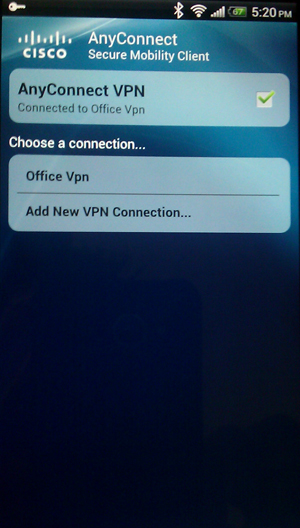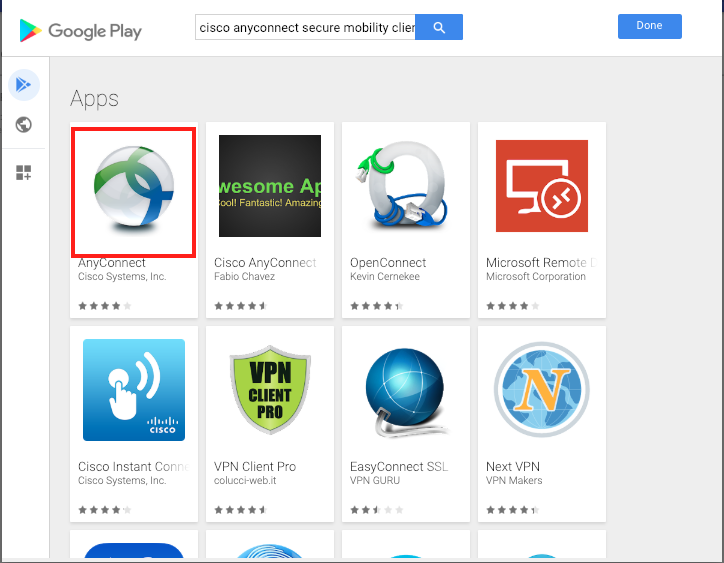Follow the steps below to install and configure Cisco AnyConnect on an Android device. Due to differences in Android devices, your steps may differ slightly. Install Cisco AnyConnect. Connect your Android device to the Internet. Go to the Google Play store. Search for AnyConnect. Select AnyConnect from the search results and click Install. Uninstall any previous versions of Cisco AnyConnect. Install Cisco AnyConnect app from the Apple App Store or Google Play Store. Open the Cisco AnyConnect app. Select Add VPN Connection. Enter a Description, for example, CMU VPN and the Server Address vpn.cmu.edu. If prompted, allow the changes. AnyConnect for Android requires Cisco Adaptive Security Appliance (ASA) Boot image 8.0 (4) or later. For licensing questions and evaluation licenses, please contact ac-temp. Cisco AnyConnect VPN Client. Uninstall all previous versions of Cisco VPN before you continue. Download the appropriate option for your operating system or device. All mobile updates are managed through Google Play (Android) or the App Store (iOS), not the university's software update process (Windows or Mac).
When using an Android device for a Cisco dCloud session, the Android device must be connected to the Cisco dCloud environment. There are two options for connecting the Android device to the dCloud environment:
Only one of these connection methods is required. Both are described below.
Connect to Wireless Network on a Router
To connect an Android device to an active Cisco dCloud session using a router configured for dCloud:
- On your Android device, go to Settings > Wi-Fi.
- From the list of Networks, select the data network associated with your router. For example, cisco-dcloud-data-kit-XX (where XX represents the identifier assigned when you registered your router).
- When prompted, type the password adgjmptw and then tap Connect.
Your Android device receives an IP address and is now active on the network.
Connect to dCloud Session Using Cisco AnyConnect
You must be logged into the dCloud UI and your session must be active to perform this activity.
Connect an Android device to an active Cisco dCloud session using Cisco AnyConnect to:
Add New Connection
To add an Android device to an active Cisco dCloud session using Cisco AnyConnect by adding a new connection:

- Connect your Android Device to a local wireless connection.
- From a browser on your Android device go to http://dcloud.cisco.com and log in with your Cisco.com credentials.
- In dCloud, go to My Hub > Sessions, locate your active session, and then Click View.
- Open Details > Session Details to view the AnyConnect Credentials for your session.
- Download and install Cisco AnyConnect from Google Play Store, if it is not already installed on your Android device.
- Launch AnyConnect.
- Tap Allow (or OK), if prompted. A confirmation window may open the first time you start AnyConnect.
- Tap Add New VPN Connection.
- In the Connection Editor window:
- Enter a Description.
- Enter the Server Address using the Host URL listed in the AnyConnect Credentials section in dCloud. In the example below, the Host URL for the dCloud RTP data center is used. The Host URL will vary, depending on the dCloud data center used to schedule your session.
- Tap Advanced Preferences.
- In the Advanced Preferences window, verify or update the following settings:
- Certificate is set toDisabled.
- To change this setting, tap the Certificate row and then choose Disabled on the Select Certificate window.
- Connect with IPsec is unchecked.
- Certificate is set toDisabled.
- Tap Done, and then tap Done again.
- In the Connections row, tap the dCloud entry you just created.
- In the AnyConnect window, enter a Username and Password from the AnyConnect Credentials section of your dCloud demo. The usernames and passwords are dynamically generated per dCloud session.
- Tap Connect.
- A message will display to confirm your connection to the dCloud environment. In the example below, the message confirms connection to the dCloud RTP Platform. The actual message will differ depending on the dCloud data center used to schedule your session. Tap Accept. Your device is now connected.
- In the Attention pop-up, place a checkmark next to I trust this application, and then click OK.
Edit Existing Connection
To add an Android device to an active Cisco dCloud session using Cisco AnyConnect by editing an existing connection:
- Launch AnyConnect.
- In the Connections row, tap the dCloud entry you want to edit.
- Tap and hold dCloud and then in the Select Action popup, tap Edit connection.
- Update the VPN connection settings as needed.
- Optionally, tap Delete connection to remove the VPN connection entry.
- Tap OK.
Topics Map > Networking > Virtual Private Networking (VPN)
This page contains links to download and installation instructions for VPN software for Android tablets, smartphones, and ereaders.

On This Page
University of Illinois students, faculty, and staff can use these directions to set up their Android devices, including some Amazon Kindles, to connect to the Virtual Private Network (VPN).
If you have a guest account, Technology Services recommends IllinoisNet Wireless for on-campus use. The VPN is most useful for off-campus use.

Note: General guidelines below
Because there are so many variations in Android device interfaces, the specific sequence required for your particular device may not be described here. University community members can contribute their specific experiences with their devices at Community-developed VPN configurations.
The images below were taken on Android 4.4.2 KitKat; your interface may vary.
Installing the VPN app
- Kindle owners: Use the Amazon Kindle store.
- All other Android owners (including Chromebooks): Use the Google Play Store.
NOTE: The AnyConnect client is not compatible with all Android devices; the Play Store and Kindle Store will inform you if your particular device isn't compatible.
When installing, you'll be prompted to agree to the permissions that AnyConnect needs, including network and phone access.
Configuring the VPN app
After you've installed the AnyConnect app on your Android or Kindle, there may be a new AnyConnect icon on your home screen, or you may need to look through All Applications to find it.
(Note that on other operating systems, you may be used to looking under 'Cisco AnyConnect' to find the VPN app; on Android it appears as 'AnyConnect'.)
- Launch the AnyConnect app.
- If prompted with an End User License Agreement (EULA), tap to accept it.
- Tap Add VPN Connection...
- In the Connection Editor, enter the following:
- Description: Urbana VPN
- Server address: vpn.illinois.edu
- (vpn.cites.illinois.edu will still work)
- Tap Done.
This will save the configuration for future use.
Logging in


- Whenever you want to use the VPN software, tap on it it from your home screen.
(If the Cisco AnyConnect icon isn't visible on your home screen, use All Applications to find it.) - Under Choose a Connection, select the Urbana VPN entry.
- You'll be prompted to enter the following information.
- Group: 1_SplitTunnel_Default
(Note: This is the most common choice. See About VPN Profiles for information about the alternatives, such as Tunnel All for access to library resources.) - Username: Your NetID
(or, if you're a guest, your guest ID) - Password: Your Active Directory password
(or, if you're a guest, your guest password) - Tap OK.
- Group: 1_SplitTunnel_Default
- If asked whether you trust this app to make a VPN connection, check I trust this application and tap OK.
- When you've connected, the On/Off toggle will show as On and the status will say Connected to Tech Services VPN.
Cisco Anyconnect Download
At this point, you can return to your Home screen and use your other apps as needed.
Disconnecting
When you're done using the VPN connection, disconnect it.
- Tap the Cisco AnyConnect app icon.
- Slide the AnyConnect VPN switch from On to Off.
Troubleshooting and the Statistics and Details screens
The Cisco AnyConnect VPN client gathers information that can help you with troubleshooting speed or connectivity issues. It may be helpful to open the Statistics and/or Details screens while troubleshooting with the Help Desk.
To open the Statistics window:
- Click the app menu icon.
- Click Statistics.
The Details button at the bottom of the Statistics screen provides additional connection information.
More help
Cisco Anyconnect 4.8 Download Windows
For more help, contact the Help Desk.
